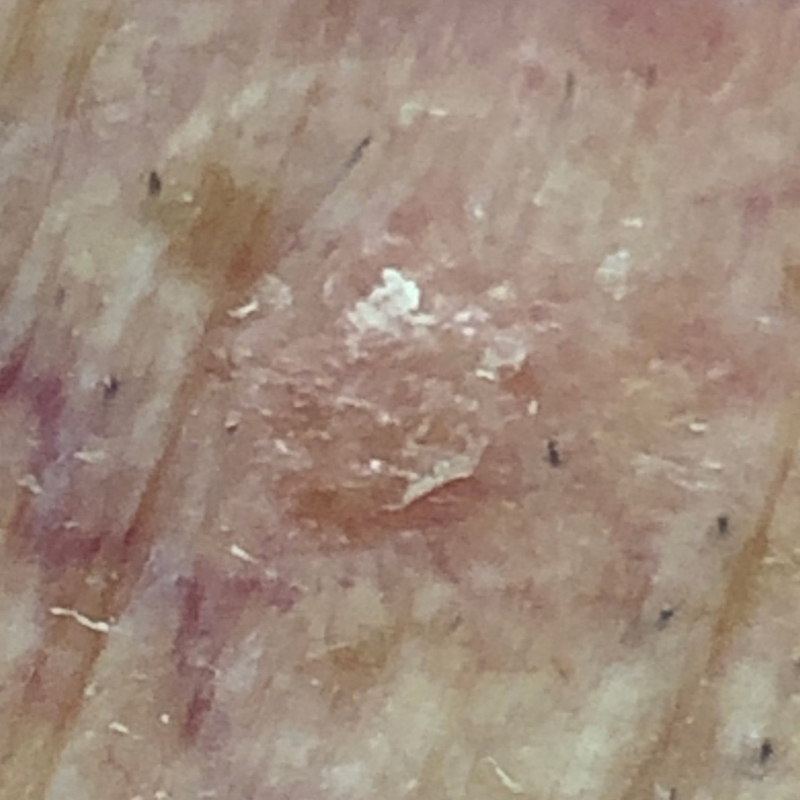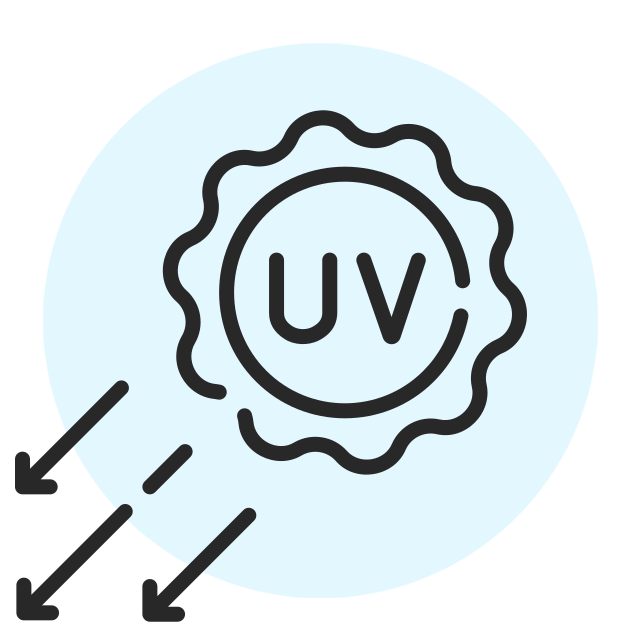Actinic keratosis (AK)

also referred to as solar keratosis, is the most common pre-cancerous growth on the skin that is caused by long-term exposure to the sun’s ultraviolet light. It appears as red, rough scaling spots. If left untreated, AK can develop into squamous cell carcinoma, a malignant form of skin cancer.

- Avoid being in the sun for prolonged periods of time from 10:00 am to 4:00 pm
- Wear sunscreen every day, at least SPF 50
- Wear protective clothes, such as long sleeves, long pants, and wide-brimmed hats.
- Avoid tanning beds.

- Avoid being in the sun for prolonged periods of time from 10:00 am to 4:00 pm
- Wear sunscreen every day, at least SPF 50
- Wear protective clothes, such as long sleeves, long pants, and wide-brimmed hats.
- Avoid tanning beds.

- Avoid prolonged exposure under sunlight between 10 a.m. to 4 p.m., wear sunscreen at least SPF 50
- Wear protective clothing covering the arms and legs, broad-brimmed hat.
- Avoid tanning beds.
- Examine your skin often.
- Occurs most often on head and neck, less often on genitals.

- Avoid prolonged exposure under sunlight between 10 a.m. to 4 p.m., wear sunscreen at least SPF 50
- Wear protective clothing covering the arms and legs, broad-brimmed hat.
- Avoid tanning beds.
- Examine your skin often.
- Occurs most often on head and neck, less often on genitals.

- Lesions/spots that are red, tan, pink, skin-colored, brown, or silvery.
- Flat or thick patches on top layer of skin, which are crusty, scaly, and rough (sandpaper-like), or hard like a fingernail.
- Small to up to an inch in size.
- Often multiple lesions, but can be solitary.
- Can be found on scalp (people who are bald or losing hair), face, side of the neck, back of hands, forearms, legs, or feet.
- A rough, dry, scaly spot on the lip.
- Typically asymptomatic, some can cause itching and stinging.

- Lesions/spots that are red, tan, pink, skin-colored, brown, or silvery.
- Flat or thick patches on top layer of skin, which are crusty, scaly, and rough (sandpaper-like), or hard like a fingernail.
- Small to up to an inch in size.
- Often multiple lesions, but can be solitary.
- Can be found on scalp (people who are bald or losing hair), face, side of the neck, back of hands, forearms, legs, or feet.
- A rough, dry, scaly spot on the lip.
- Typically asymptomatic, some can cause itching and stinging.

- The doctor will do a visual skin examination and may use a bright light, magnifying lens or a dermatoscope.
- If the spot is hard, bleeding or increasing in size rapidly and reaches a certain size, a biopsy can be performed.

- The doctor will do a visual skin examination and may use a bright light, magnifying lens or a dermatoscope.
- If the spot is hard, bleeding or increasing in size rapidly and reaches a certain size, a biopsy can be performed.

- Early treatment is recommended to avoid progression to squamous cell carcinoma.
- Commonly treated with cryotherapy (using liquid nitrogen to freeze the lesion), and is an effective treatment option if there are only a few lesions. Post treatment lesions blister, peel, crust and disappear within 10 to 14 days.
- Curettage and electrodesiccation procedure, by scraping the lesions with a spoon-shaped instrument called curette, then cauterizing (burn) the area
- Chemical peels may be applied to the lesions causing blistering and eventual peeling. Skin peeling usually lasts for 5 to 7 days.
- If there is a bigger area of the skin with multiple AKs, the doctor might prescribe medicated cream or gel to apply on the whole area. The lesions will become red and sore, then crust over, and eventually fall off. Majority of lesions clear typically in 2 to 3 weeks
- Photodynamic therapy uses a special intense laser light to activate photosensitizing medicated cream applied to the area of multiple AKs to treat them.

- Early treatment is recommended to avoid progression to squamous cell carcinoma.
- Commonly treated with cryotherapy (using liquid nitrogen to freeze the lesion), and is an effective treatment option if there are only a few lesions. Post treatment lesions blister, peel, crust and disappear within 10 to 14 days.
- Curettage and electrodesiccation procedure, by scraping the lesions with a spoon-shaped instrument called curette, then cauterizing (burn) the area
- Chemical peels may be applied to the lesions causing blistering and eventual peeling. Skin peeling usually lasts for 5 to 7 days.
- If there is a bigger area of the skin with multiple AKs, the doctor might prescribe medicated cream or gel to apply on the whole area. The lesions will become red and sore, then crust over, and eventually fall off. Majority of lesions clear typically in 2 to 3 weeks
- Photodynamic therapy uses a special intense laser light to activate photosensitizing medicated cream applied to the area of multiple AKs to treat them.

- After treatment, it is important to follow up with the doctor periodically. This is important to check for recurrence or any new lesions

- After treatment, it is important to follow up with the doctor periodically. This is important to check for recurrence or any new lesions
Seborrheic Keratosis (SK)

(SK) also known as Benign Keratosis is a protuberance on the skin due to a localized overgrowth of the horny outermost covering of the skin. More generally, keratosis is any skin disorder related to horny growths. Seborrheic keratosis is a type of keratotic skin disorder and a common type of benign skin growth. It is estimated that over 90% of adults over the age of 60 have developed seborrheic keratosis.
It is caused by the benign proliferation of immature keratinocytes (specialized skin cells that produces the protein keratin). They are slow-growing, increases in thickness over time to become wart-like. Rapid growth and emergence of multiple seborrheic keratoses is associated with underlying malignancy such as adenocarcinoma of the GI tract, leukemia, and lymphoma.

- Age-related
- Family history of seborrheic keratosis the, perhaps genes play a role
- Eruptive seborrheic keratoses can follow sunburn or dermatitis
- Appear in body folds so skin friction may take a role

- Age-related
- Family history of seborrheic keratosis the, perhaps genes play a role
- Eruptive seborrheic keratoses can follow sunburn or dermatitis
- Appear in body folds so skin friction may take a role

- Flat or slightly raised with a scaly, waxy, and warty surface, has a “pasted on” look
- Round or oval
- Usually brown, but can be yellow, white, or black
- Appears typically on the face, chest, shoulders and back.
- Solitary or grouped in certain areas, typically on the face, chest, shoulders and back over the spine; can be in the groin, under the breasts or within the scalp
- 1mm to more than 2.5 cm
- May be itchy

- Flat or slightly raised with a scaly, waxy, and warty surface, has a “pasted on” look
- Round or oval
- Usually brown, but can be yellow, white, or black
- Appears typically on the face, chest, shoulders and back.
- Solitary or grouped in certain areas, typically on the face, chest, shoulders and back over the spine; can be in the groin, under the breasts or within the scalp
- 1mm to more than 2.5 cm
- May be itchy

- Doctor can tell if the skin growth is a seborrheic keratosis by visual examination with their eyes or using dermoscopy. (using a dermatoscope, a hand-held high quality magnifying lens and a powerful lighting system to examine the skin surface)
- Sometimes it is difficult to differentiate cancer and seborrheic keratoses, in this case a biopsy would be performed by shaving off the growth and examined under a microscope in the lab.
- For rapid growth and emergence of multiple seborrheic keratoses, order cancer screening tests

- Doctor can tell if the skin growth is a seborrheic keratosis by visual examination with their eyes or using dermoscopy. (using a dermatoscope, a hand-held high quality magnifying lens and a powerful lighting system to examine the skin surface)
- Sometimes it is difficult to differentiate cancer and seborrheic keratoses, in this case a biopsy would be performed by shaving off the growth and examined under a microscope in the lab.
- For rapid growth and emergence of multiple seborrheic keratoses, order cancer screening tests

- Usually, seborrheic keratoses do not need treatment due to their benign nature
- If the lesions are in an inconvenient spot, get caught on clothing or for cosmetic reasons, seek options to remove them
- Cryotherapy – apply liquid nitrogen to freeze and destroy the growth, blister forms under the seborrheic keratosis and dries into a scab-like crust that would fall off within days.
- Electrosurgery and curettage – involves using an electric current to destroy the growth. A curette, scoop-shaped instrument, is used to scrape off the treated growth.
- Vaporizing the growth with a laser (ablation)
- Applying a solution of 40% hydrogen peroxide is effective in removing the growths, but may irritate the skin
- After the seborrheic keratosis is removed, the growth does not return, however a new one may occur in another location

- Usually, seborrheic keratoses do not need treatment due to their benign nature
- If the lesions are in an inconvenient spot, get caught on clothing or for cosmetic reasons, seek options to remove them
- Cryotherapy – apply liquid nitrogen to freeze and destroy the growth, blister forms under the seborrheic keratosis and dries into a scab-like crust that would fall off within days.
- Electrosurgery and curettage – involves using an electric current to destroy the growth. A curette, scoop-shaped instrument, is used to scrape off the treated growth.
- Vaporizing the growth with a laser (ablation)
- Applying a solution of 40% hydrogen peroxide is effective in removing the growths, but may irritate the skin
- After the seborrheic keratosis is removed, the growth does not return, however a new one may occur in another location

- If clothing irritates the seborrheic keratosis, a bandage covering it can prevent rubbing and bleeding
- Check at home regularly for suspicious skin lesions of the whole body

- If clothing irritates the seborrheic keratosis, a bandage covering it can prevent rubbing and bleeding
- Check at home regularly for suspicious skin lesions of the whole body